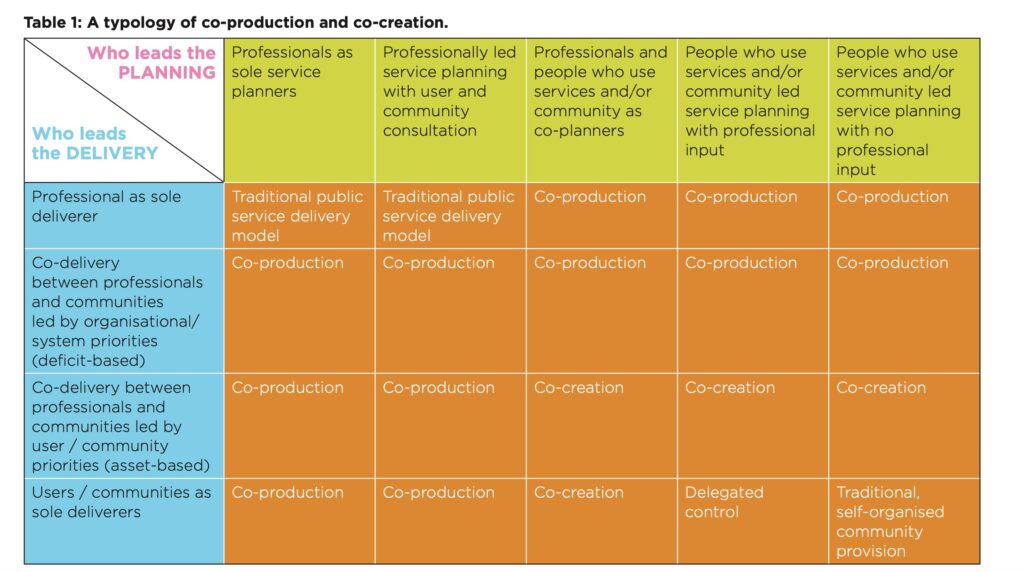What is co-creation?
In CoSIE we see co-creation as a collaborative activity that reduces power imbalances and aims to enrich and enhance the value in public service offerings.
Co-creation implies that value of service offering is enhanced in the interactions between participants.
Value may be understood in terms of increased well-being and shared visions for the common good that lead to more inclusive policies, strategies, regulatory frameworks or new services.
In this project, by exploring innovative action to support co-creation we wanted to understand what co-creation actually is and how it differs from other forms of participation in public service renewal. In this section we offer
- A clarified and deepened conceptualization of the co-creation concept
- Co-creation in relation to other terms, such as co-production
Co-creation is often confused with other related terms and this might hinder the shift to the new paradigm in managing and delivering public services.
- Co-creation is not only or primarily a technical skill that can be quickly learned, although it often requires adopting new dialogue techniques and sometimes even new use of digital technologies. It is first of all a (novel) approach among service professionals and managers to the citizen who is assisted by services, to service ethics and management.
- It is about a shift in the approach to service aims, roles and relationships away from one-way or top-down, faceless, distant, impersonal and sometimes inadequate service delivery in addressing social problems. Instead, it is about enhancing citizen wellbeing, embracing their human worth and equalizing power. It requires involving citizens and stakeholders, and listening to each other in defining service aims, design and delivery. The Valencian example of public employment services in CoSIE illustrates citizen and service professionals dialogical interactions and contributions along the entire service circle.
- Co-creation competes with other management logics as it focuses on mutual interdependency and dialogical interactivity between citizens assisted by services and service professionals or other stakeholders in service value enhancement.
- It is associated to but is more than co-production. It requires that concerned individual citizens as service users (or their organized groups) participate in and drive forward service improvement or development – its design, planning, initiation and implementation –in close collaboration with service professionals and other stakeholders. In co-production people who use services take over some of the work done by practitioners (see Table 1, left side) whereas in co-creation, people who use services work with people who manage and deliver services.
- Another difference is that co-production has involved a once in while involvement of citizens (examples being occasional dialogues in town planning or patients following prescribed action in out-hospitalization) while the co-creation often requires repetitive citizen involvement and in the entire service circle. In CoSIE, systematic use of living labs, innovative local/regional partnerships and changes in citizen roles in novel or improved service delivery practices were all examples of co-creation. A good CoSIE example is marginalized youth acting as experts in social service planning, re-design and delivery in rural Finland.
- Co-creation might differ from community development, especially if community development is taken to mean that citizens as service users are the sole or major initiators and drivers of community development – based on their knowledge, experience and chosen tools – with no or occasional help from public sector workers (see Table 1, lower right hand corner). Examples of that may be publicly co-financed sports clubs run by communities of volunteers with occasional help from professional public services. In co-creation, all parties make substantial, often long-term contributions.

- Co-creation assumes a collaborative and dialogical element from service the earliest phases of analysis and design to delivery and assessment, and it might imply an element of co-steering (by service co-governance and co-management). There are obvious similarities with collaborative governance, our Italian example being an illustrative case, but co-creation involves citizens or laymen and is more focused on innovations – in services, organizational practices, relationships and management approach. Co-creation is more ambitious as it requires proactive creation and orchestrating of proper settings – platforms, tools and actors – and support with skills.
- Who benefits? Co-creation produces value for citizens, enterprises and society as a whole (public and private value).
- Co-creation of public value is about enhancing service value for individuals and for broader citizen and societal groups. Often the value is enhanced through co-creation with variety of stakeholders (for instance, to enhance the value of youth obesity services the youth, parents, doctors, nurses, social service officials, teachers, sport club leaders and many more may need to collaborate as in our Italian case). Co-creation fulfills a human need to be involved beyond electoral participation in services that concern individuals, and this way empowers and achieves greater wellbeing or flourishing of persons through their interaction (se also Torfing et al, 2021).
- Also elected politicians and public managers may benefit from co-creation by enhanced input and output legitimacy. Co-creation contributes with better understanding of societal needs, solving some fiscal constraints and (re)distribution of resources.
Yet, there is a dark side to co-creation such as encountering negligence, unfulfilled promises, incompetence or stigmatization of non-contributors, limited transparency and accountability, administrative costs, risk of government overload, sometimes limited possibility of central planning and holistic coordination (see also Torfing et al, 2021).
Learn more:
Fox, C, Baines S., Wilsson, R., Jallonen, H, Narbutaite Aflaki, I., Pradini, R., Bassi, A., Ganugi, G., Aramo-Immonen. (2021). A New Agenda for Co-creating Public Services. Turku university of Applied Sciences: Turku. (Available here)
Torfing, Ferlie, Jukic, Ongaro(2021).A Theoretical framework for studying Co-creation of innovative solutions and public value, In Politics and Policy. Volume 49, Number 2,pp. 189-209(21)
Bovaird, T. (2007) Beyond engagement and participation: user and community coproduction of public services. Public Administration Review 67:5, 846–860.
Ansell, C. and Torfing, J. (2021) Public Governance as Co-creation, Cambridge: Cambridge University Press.